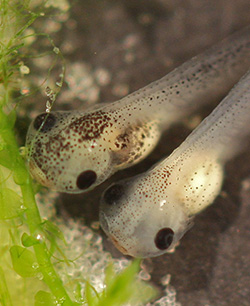Light Triggers a New Code for Brain Cells
November 12, 2008
By Susan Brown
Brain cells can adopt a new chemical code in response to cues from the outside world, scientists working with tadpoles at the University of California, San Diego report in the journal Nature this week.

More than skin deep. After exposure to constant light, cells in the pale tadpole's brain adopted a new chemical code to control its skin pigments.
Credit: Norma Velazquez Ulloa Armando de la Torre and Krista Todd
The discovery opens the possibility that brain chemistry could be selectively altered by stimulating specific circuits to remedy low levels of neural chemicals that underlie some human ailments.
Dark tadpoles don pale camouflage when exposed to bright light. The researchers have now identified cells in the tadpole brain that respond to illumination by making dopamine, a chemical message, or neurotransmitter, recognized by the system that controls pigmentation.
"We used to think activity turned a switch to specify which transmitters a neuron would use only in early development," said co-author Davide Dulcis, a postdoctoral fellow in neurobiology who designed and conducted the experiments. "But this is happening after hatching."
The cells, found in a cluster called the suprachiasmatic nucleus, connect to a gland that releases a hormone that disperses pigments to darken skin. Dopamine squelches hormone release leaving pigments tightly packed in skin cells and the tadpoles nearly transparent.
"The behavior meets an ecological need." Dulcis said. "Pale tadpoles are difficult for predators to see in a bright environment, so the faster the tadpoles change their pigmentation, the better they are able to survive."
Cells in the core of the cluster always make dopamine, but a ring of surrounding cells normally don't, even though they are connected to the gland.
Bright light alters this pattern, however. After just two hours, cells in the surrounding ring show signs of making the new neurotransmitter. Because they are already hooked up to the hormone-producing target, illumination can result in noticeably paler tadpoles in as little as ten minutes.
"The new dopamine neurons are not simply activated at random," said co-author Nicholas Spitzer, a professor of neurobiology who leads the research group. "It's as if they are a kind of national guard, waiting in reserve to be called out. There's a pool of neurons waiting for the right sensory stimulus to be called into action and to adopt a new transmitter."
The signal-switching cells receive a link directly from the eye and are part of a brain circuit shared by a variety of animals from bony fish to humans. Although these cells don't contribute to vision, they do monitor light levels for other purposes, particularly for coordinating daily rhythms of physiology and behavior.
Activity might alter brain chemistry in other circuits as well, the researchers say. Light helps people who experience seasonal affective disorder, for example. Their symptoms of depression, which descend during long winter nights, lift in summer and also abate when they are regularly exposed to bright light, a therapy that can be as effective as anti-depressant drugs.
"Maybe it's the case that for many neurons there is additional circuitry that can be activated under certain circumstances," Spitzer said.
Depleted brain chemistry underlies several diseases, including Parkinson's. If a reserve pool of neurons could be identified and recruited by stimulating particular neural circuitry some of the side effects that stem from flooding the entire brain and body with drugs designed to boost levels of specific neurotransmitters might be avoided, he said.
The National Institutes of Health funded the study.
